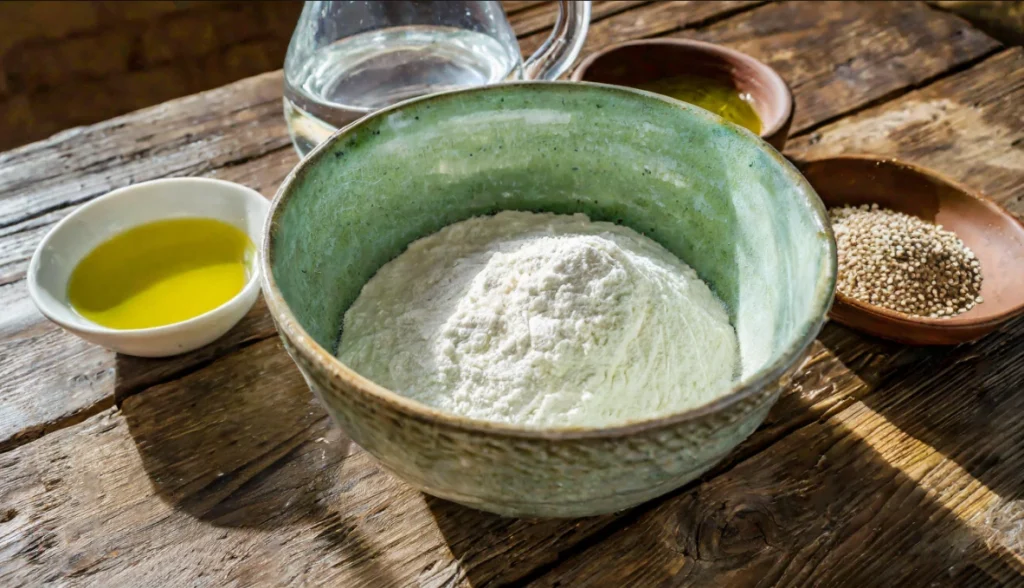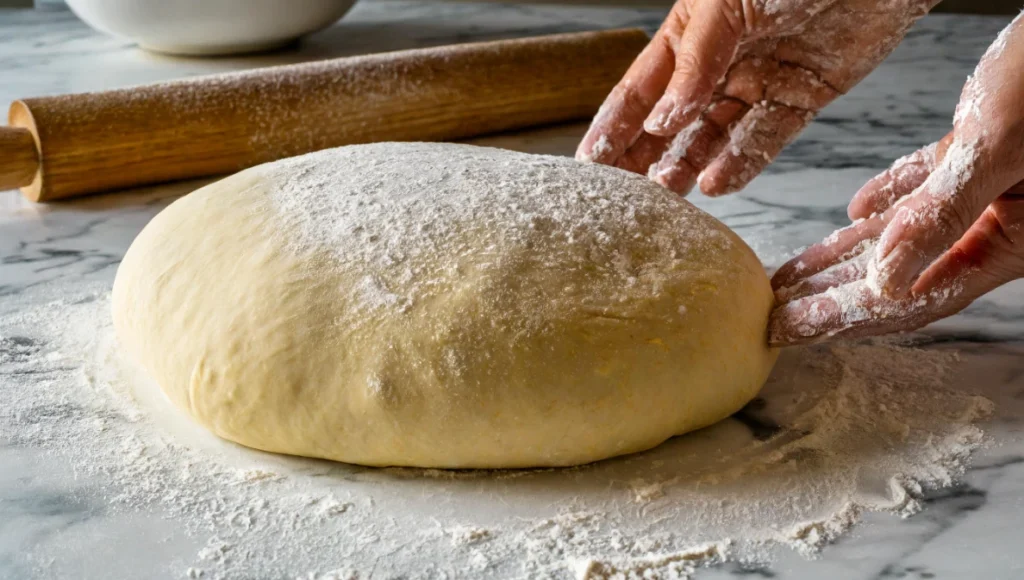
Introduction to 00 Flour Pizza Dough recipe
The quest for the perfect homemade pizza often begins with the choice of flour. 00 flour, known for its fine texture and high elasticity, is the gold standard among pizza aficionados. This ultra-fine Italian flour works wonders for pizza dough, offering a balance of crunch and chewiness that’s hard to achieve with other types.
The use of 00 flour in pizza dough has roots deep in Italian culinary tradition. Originating from Italy, this flour is milled to a fine powder, which is crucial for creating the tender, yet crispy crusts associated with authentic Neapolitan pizzas. The key lies in its protein content, which, while not as high as bread flour, strikes the perfect balance for pizza dough. Exploring the origins of pizza farming reveals more about how traditional ingredients shape the flavors we continue to cherish.
Making the Dough: Step-by-Step Guide
Ingredients and Substitutions

Crafting the perfect 00 flour pizza dough recipe begins with assembling the right ingredients. You’ll need:
- 1 kg (about 8 cups) of 00 flour. While 00 flour is preferred for its texture, all-purpose flour can be a substitute in a pinch.
- 3 cups of lukewarm water
- 3 tablespoons of olive oil, plus more for drizzling
- 1 tablespoon of active dry or instant yeast
- 1 tablespoon of kosher salt, plus a pinch for topping
- 1 tablespoon of sugar
- Optional: Cornmeal for dusting the pizza peel
Mixing the Dough
The process of mixing the dough is straightforward but crucial for the end result. Begin by combining the lukewarm water with olive oil, yeast, salt, and sugar in a large mixing bowl. Gradually add the 00 flour, stirring continuously to avoid lumps. Once the dough begins to come together, transfer it to a floured surface and knead until it’s smooth and elastic. This step is essential for developing the gluten, which gives the dough its structure and chewiness.
Rising and Proofing
Allowing the dough to rise is a step you cannot skip. After kneading, place the dough in a lightly oiled bowl, covering it with a clean cloth. It needs to rest at room temperature for about 2 hours, or until it doubles in size. This process, known as proofing, is crucial for developing the flavors and texture of the dough. For those interested in the science behind it, exploring resources like Innovative pizza dough recipes can provide deeper insights.
Crafting the Perfect Pizza
Shaping and Preparing the Dough for Baking

After the dough has doubled in size, it’s time to shape it into balls for individual pizzas. Divide the dough into 8 equal parts. Shape each part into a ball by pulling the sides to the center and then turning it seam-side down. The key to a good base is to then flatten the dough ball with your hands and stretch it out from the center. You can use a rolling pin, but to preserve the air bubbles that contribute to a lighter crust, stretching by hand is preferred.
Position your oven rack in the lower third of the oven and place a pizza stone on it. Preheat your oven to its highest setting, usually between 475°F to 500°F (245°C to 260°C). This high heat replicates the conditions of a traditional pizza oven and is essential for a crisp crust.
Choosing Toppings and Baking the Pizza
When it comes to toppings, less is more. Start with a base of tomato sauce, spreading it thinly over the dough. Add chunks of fresh mozzarella and a few basil leaves for a classic Margherita. Remember, the quality of your ingredients will shine through, so choose them wisely. Before sliding the pizza onto your preheated stone, give it a final drizzle of olive oil.
Baking takes about 8 to 10 minutes. Keep an eye on the pizza; it should emerge with a golden crust and bubbling cheese. Let it cool for a few minutes before slicing. This resting period allows the cheese to set and makes for cleaner slices.
Finishing Touches and Serving
Presentation is the final step in the pizza-making process. Transfer your pizza to a wooden board for a rustic feel, or serve it directly on a sleek, round tray for a more modern look. Pair it with a light salad to cut through the richness of the cheese and dough. A glass of red wine, perhaps a Chianti or Montepulciano, can elevate your pizza to a full dining experience.
FAQs: about 00 flour pizza dough recipe
To round off this guide, here are answers to some common queries about making 00 flour pizza dough:
- Can I use any flour for pizza dough? Yes, but 00 flour gives the best texture.
- What temperature should the water be for the dough? Lukewarm, around 100°F (38°C), is ideal.
- Can I store the pizza dough? Absolutely, it can be refrigerated for up to a week or frozen for two months.
- Do I need a pizza oven? No, a high-temperature setting in your regular oven will suffice.
- Do I need to put cornmeal on the pizza peel? It’s not necessary, but it helps the pizza slide off the peel.
- Does the pizza dough need to rise before baking? Yes, for about 2 hours at room temperature.
- What toppings are best for homemade pizza? Stick to a few quality ingredients for the best results.
Making pizza at home is a rewarding experience, and with this 00 flour pizza dough recipe, you’re well-equipped to create something truly special. For those eager to delve even further into the world of homemade pizza, exploring additional resources like Revolutionizing homemade bread and pizza can offer more insights and inspiration.
For more pizza inspiration, you might enjoy exploring similar dishes like Butter Crust Pizza, which showcases another delightful way to enjoy pizza in your home cooking.
Remember, the beauty of pizza lies in its simplicity and the joy it brings to those who share it. Whether you’re a seasoned chef or a first-time baker, the perfect pizza is within your reach. Buon appetito!
